  Long time ornamental grass grower Emerald Coast Growers, headquartered in Pensacola, Fla., knew it was time to expand when its production of perennials started to match its numbers for grass production. Forecasting a minimum 10 percent annual growth in its perennial program, the company recently added new greenhouses at two of its Florida locations. Long time ornamental grass grower Emerald Coast Growers, headquartered in Pensacola, Fla., knew it was time to expand when its production of perennials started to match its numbers for grass production. Forecasting a minimum 10 percent annual growth in its perennial program, the company recently added new greenhouses at two of its Florida locations.“With perennials ramping up and our grass program’s continued robustness, we knew it was time to make the move,” said Paul Babikow, Emerald Coast Growers president of operations. “We see great potential for growth. In fact, we could already use more perennial propagation space.” That need for more space is on top of the current expansion, which includes adding 35,000 square feet of XS Smith Criterion greenhouses. The grower allocated just under ½ acre at its 50-acre Milton location, which is designed for grass production. Another 15,696 square feet in perennial propagation space was added to its Pensacola facility. “We needed a newer custom gutter-connected house that we could bump up the height on,” Babikow said. “Airflow is a huge concern for us with the Florida heat and humidity. The high sidewalls and removable gables are ideal for us.”  With sanitation being critical in perennial propagation, the new greenhouses have been equipped with concrete floors and benches and the facilities are phytosanitary certified. With sanitation being critical in perennial propagation, the new greenhouses have been equipped with concrete floors and benches and the facilities are phytosanitary certified.At Milton, the expansion consists of eight gutter-connected bays that measure a total of 18,432 square feet. The range features 8-foot sidewalls and has a total capacity of 8,448 trays. For the new perennial propagation houses in Pensacola, the installation was split into two houses with 10-foot sidewalls. Three gutter-connected bays measure a total of 5,616 square feet and hold 2,220 trays. The second range of five gutter-connected bays total 10,080 square feet and hold 4,026 trays. With sanitation being critical in perennial propagation, the new houses have concrete floors. Everything is benched and the facilities are phytosanitary certified.  At both the Milton and Pensacola locations, all of the new houses are equipped with roll-up sides with removable gables. At both the Milton and Pensacola locations, all of the new houses are equipped with roll-up sides with removable gables.At both locations, all of the new houses are equipped with roll-up sides with removable gables, Lithonia Lighting high pressure sodium lights and Phytotronics Gemini mist systems. This set up provides the flexibility to produce a variety of crops with different requirements. Fluid locations With the greenhouse expansion will come shifts in production to match crops with the ideal production environment. For example some of the grass production previously done in Pensacola will be moved to Milton to free up more space for perennials. Production always remains fluid and dynamic at Emerald Coast. “We have four locations and each offers different benefits for production,” said sales manager Cheri Markowitz. “We can produce at one location, then move to another location to hold product.” The Milton facility is primarily used for grass division and production with field grasses being a predominant crop. The company’s Pace, Fla., facility is used primarily for perennial production. Its mist houses are used for propagating cuttings, which are produced in-house and also brought in from other cutting suppliers. In Pensacola the focus is on grass production, including divisions and seed grasses. Plants here are produced in smaller crops and then moved to the Milton location for finishing. The company also has a cold crop facility in Lancaster, Pa., that is completely screened for Japanese beetles and is West Coast certified.  This year Emerald Coast Growers added 122 new perennial and 16 new ornamental grass varieties. This year Emerald Coast Growers added 122 new perennial and 16 new ornamental grass varieties.Flexible production With the new structures, Emerald Coast can easily shift from finished ornamental grass production where temperature management isn’t as critical to cutting propagation and tissue culture where climate control is essential. The grass houses are used to produce large crops of 100-150 varieties. These houses have been set up with larger zones for misting providing more control over a broader scale. In the perennial houses, a large number of species are produced in small lots. The plants are tabled in smaller batches for tighter control and easier misting so they can control each batch separately. “Having mist systems and lighting in place has really opened up possibilities for us,” said Josiah Raymer, head grower/general manager. “We can extend photoperiod in winter and keep a house upwards of 70°F if necessary.” Another difference in the perennial propagation ranges: 36-inch counter height peninsula benching. Each house has a wide center aisle and narrow side aisle with a 24-inch wide bench that runs a minimum of 24 feet. “Our team does the work right on the benches, and that makes an impact on labor,” Raymer said. “It’s easier on people sticking cuttings, especially with frequent turns every four weeks or so.”  High pressure sodium lights and mist systems installed in the new structures help to provide flexibility to produce a variety of crops with different requirements.Critical airflow High pressure sodium lights and mist systems installed in the new structures help to provide flexibility to produce a variety of crops with different requirements.Critical airflowRaymer said the company uses natural airflow as often as possible. “That provides cost efficiencies and also benefits like reducing disease pressure,” he said. Being located in the Florida Panhandle, the company has to compensate for the heat and humidity. Four Schaefer horizontal airflow fans per bay deliver continuous air circulation. Adding an extra 2 feet of sidewall also makes a big difference and provides even more flexibility.  The new perennial propagation ranges have been equipped with automated gable fans and intake shutters for winter venting. The new perennial propagation ranges have been equipped with automated gable fans and intake shutters for winter venting.“We know from our other houses that rolling up the sidewalls and curtains and taking out the gable ends has a significant impact on greenhouse air movement,” Babikow said. “With the new construction we can go from a very tightly sealed house to an extremely open house very quickly.” Another addition that contributes to energy management and savings is the double inflated infrared/anti-condensate polyethylene film roof. Florida’s Panhandle experiences some cool nights and the double poly film helps manage heat loss. The poly roofs provide another benefit. “Here in Hurricane Alley we need to be able to remove the roof to prepare for a storm,” Raymer said. “If a hurricane comes we just take the tops off and save the houses.” The new structures provide Emerald Coast with the production flexibility and agility it needs and the ability to capitalize on potential market growth. “We see needing more perennial space in the future, but of course need always comes before ability,” Babikow said. “We’re customer- and broker-driven, and this expansion helps us focus on being responsive to and anticipating their needs.”  President of operations Paul Babikow and sales manager Cheri Markowitz expect to see continuing increases in sales with the addition of 138 new perennial and ornamental grass varieties. From grasses to perennials President of operations Paul Babikow and sales manager Cheri Markowitz expect to see continuing increases in sales with the addition of 138 new perennial and ornamental grass varieties. From grasses to perennialsEmerald Coast Growers is celebrating its 20th anniversary this year with a major perennial production expansion, and it’s an irony not lost on Cheri Markowitz, sales manager and daughter of founder and ornamental grass pioneer David Babikow. “Grasses are a perennial; they’re just a larger niche within the perennial market,” Markowitz said. “Perennials are in our family history. My father was instrumental in putting perennials in cell packs in the ’70s.” Babikow and his wife Wyona carried that forward-thinking philosophy through when they founded Emerald Coast Growers, first focusing on ornamental grass starter plants, then expanding to perennial plants in the late ’90s. This year the company added 122 new perennial and 16 new grass varieties, maintaining its signature ornamental grass program. Emerald Coast is one of the country’s largest liner producers and continues to expand its growth in perennial plants. To determine which crops to expand, Emerald Coast looks at trends, demand and how crops fit into existing structures and with the worker base, Markowitz said. The company also does a lot of speculation. “Ours is a speculative business, but we have to have the right plants at the right time,” she said. “It’s essential that we stay nimble, that we’re able to answer customer needs at any time. In fact we have no cutoff date for orders.” The company’s flexibility is seen in its many new offerings, including larger and smaller plug sizes. Top selling Pennisetum xadvena ‘Rubrum’ is offered in four different plug sizes. A new custom 128 program provides more opportunity. “We will produce almost anything we grow in the 128, and we’ll still speculate, even on the smaller sizes,” Markowitz said. “Our goal isn’t to design a rigid program but to be the vendor of choice.” For more: Emerald Coast Growers, (877) 804-7277; www.ecgrowers.com. Joli A. Hohenstein is marketing and PR specialist, Pen & Petal Inc., www.penandpetal.com. |

Explore the August 2011 Issue
Check out more from this issue and find your next story to read.
Latest from Greenhouse Management
- Flexible fungicides
- Super Charged Moon Juice from Moon Valley Nurseries now available nationally
- 2025 Proven Winners Horticulture Scholarship applications now open
- How to improve inventory and shipping management in the greenhouse
- Leading Women of Horticulture: Anna Ball, Ball Hort, and Terri McEnaney, Bailey Nurseries
- GM CEA HERB Part 2: A guide to increasing the sowing density of culinary herbs
- GM CEA HERB Part 1: Best practices for producing culinary herbs in controlled environments
- USDA fires experts on invasive pests, including Asian citrus psyllid, chilli thrips





